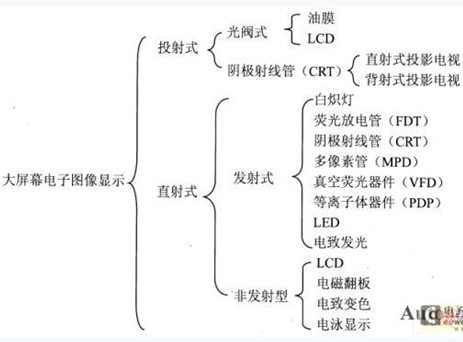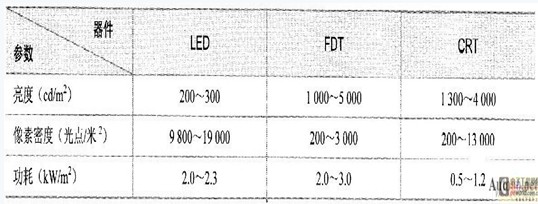The classification of large-screen electronic image display technology is as follows: The projected-on-screen display system relies on optical projection to image, using fewer devices and lines, and at a lower cost. The technical defects are low brightness, poor contrast, and a large space occupied by the projection device, which is only suitable for general indoor screens. The direct-on-screen display system uses various types of light sources as the light-emitting units of the screen, and is inlaid into a huge matrix for video and image display. Its brightness and pixel density technology have been increasingly developed in recent years, showing its vitality. The characteristics of various typical large-screen display technologies are described below. (1) TV wall The video wall is a technology that decomposes the synchronization signal and displays an image simultaneously with not less than two imaging units. The circuit is relatively simple. Early video walls used ordinary picture tubes as a unit. Since the composite image gap is too small, the image is divided after the plane is right angled, so a video wall composed of a rear projection type television display unit appears, which is low in brightness and is suitable only for indoor use. (2) LED display The LED is an electroluminescent device with an emission wavelength from 480 nm (blue light) to 700 nm (red light) ff: The LED is greatly improved in technology. LEDs are used as display screens for light-emitting devices. They are widely used in various types of displays due to their simple circuit, low power consumption and low driving voltage. (3) incandescent bulb display The large-screen display of the light bulb matrix was born with the development of computer-controlled matrix addressing technology. This bulb screen was used in the 23rd Olympic Games in Los Angeles. In the bulb screen system, each group of bulbs is red, green, blue, and white. Each bulb is controlled by a juice machine to display text, graphics, or no grayscale cartoons. In recent years, the bulbs used in the bulb screen have been developed in the direction of miniaturization and energy saving. A new light source with a reflective glass envelope containing a small size tungsten halogen quartz bubble is being introduced into the bulb screen system. The bulb screen has a nonlinearity between the brightness and the filament heating current, which complicates the gradation modulation circuit, which limits its application. (4) LCD display The LCD display is a transmissive LCD as a display unit. The advantage is that the volume is small and the power consumption is saved; the disadvantage is that the brightness is insufficient and the application range is small. The LCD display has the following main features: 1 The power consumption is extremely low, and the display panel consumes only a few microwatts to several tens of microwatts per square centimeter. 2 The working voltage is low, about 10V. 3LCD is a non-self-illuminating display, so it is more vivid and brighter in brighter occasions. (5) CRT/FDT color large screen CRT is a cathode ray tube (Fathode Ray Tube), and FDT is a Fluorescent Discharge Tube. The principle of the two lights is not the same. The former uses a cathode ray to bombard the phosphor to emit light; the latter is an ultraviolet photon excited by the mercury atom in the negative ion state, and the ultraviolet photon re-excites the phosphor to emit light. The giant display screened with CRT or FDT light-emitting devices is the most successful large screen currently used. The brightness is high, the color reproduction ability is strong, the power consumption is low, the pixel density is high, and the life is long, so that the information amount of the display system is far more than the traditional gray scale system, and is the highest technical level in the advertisement display medium. The matrix display system consisting of these two types of light-emitting devices is clearly superior to the LED or incandescent lamp matrix. In order to obtain a satisfactory outdoor color screen display, the following requirements are imposed on the light emitting device: 1 In order to be able to see colorful video images from the screen at the moment of the sun, in order to achieve the requirements of all-weather display, the screen must have a brightness of too much 200cd/m2. 2 Light-emitting devices should have high photoelectric conversion efficiency. This is because the device in the system has tens of thousands of light-emitting devices, and the power consumption is too high. The difference in efficiency depends on the light-emitting device, which consumes substantially 0.5 to 3 kW/m2. 3 Short response time (avoiding rabbit lag image), should be able to display TV images of 50 ~ 60Hz. 4 color reproduction ability is strong. This means that the color purity and color coordinate values ​​of the light-emitting device must meet the requirements. 5 Longer life, required for thousands of hours or even higher. Typical technical data for several light-emitting devices are shown in Table 1. Table 1 Typical technical parameters of several light-emitting devices Commercial Coffee Urn,Coffee Urn,100 Cup Coffee Urn,Large Coffee Urn FOSHAN FORTUNE ELECTRICAL APPLIANCE CO.,LTD , https://www.coffelady.com
